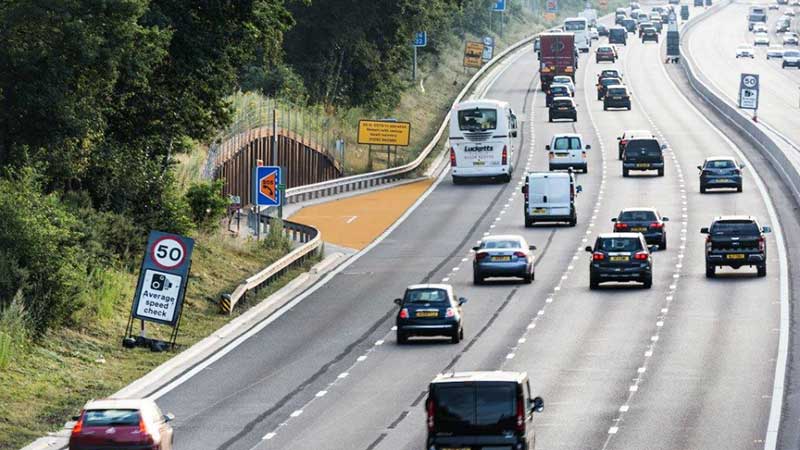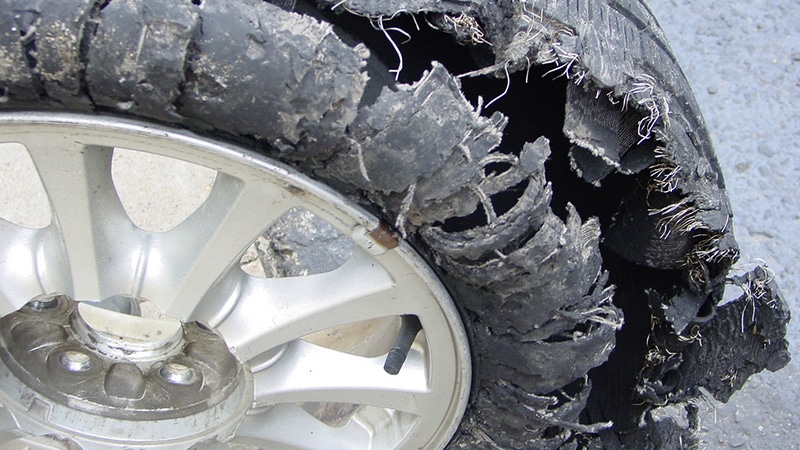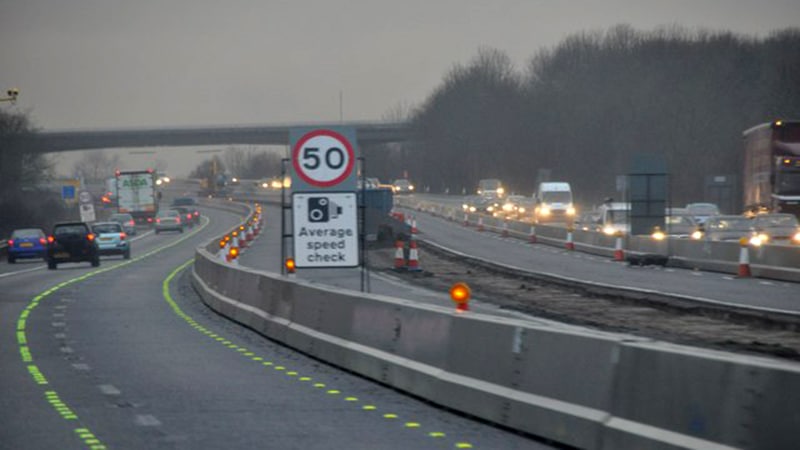Motorways are statistically among the safest roads to drive on, but experiencing a problem that means you need to stop will dramatically increase danger levels. Read on to ensure you know what to do in the event of breakdown, puncture or minor collision on one of the UK’s motorways.
From standard motorways with hard shoulders to ‘smart’ motorways with Emergency Refuge Areas, here’s our guide to planning ahead when driving on these major transport arteries.
STOPPING ON A ‘STANDARD’ MOTORWAY WITH A HARD SHOULDER
Here’s what to do in an emergency on a ‘standard’ motorway that includes a hard shoulder.

Find out how to get to safety on a ‘normal’ motorway with a hard shoulder
1) Stay calm and head for the hard shoulder or leave at the next junction
If your car is still able to drive: If the ‘problem’ doesn’t require an instant stop – such as an engine warning light – you should move to the inside lane, reduce your speed (but not enough to cause a hazard to other faster moving vehicles) and head to the nearest junction or service station. Remember, HGVs are likely to be travelling at 56mph in the inside lane.
If you need to stop right away: Keeping calm and being prepared for what to do in the event an incident is essential. The first few seconds of the developing situation are likely to make getting to safety much easier. Firstly, don’t simply slam on the brakes if your car is still moving and in control. For instance, if the power fails, use your momentum to make your way safely across the lanes and park on the hard shoulder with your hazard lights on. If it’s dark, ensure your sidelights are left illuminated.
2) Be prepared for changes to your car’s handling
If the engine has died, it’s likely that ancillary systems such as brakes and steering will become difficult or ‘different’ to use. With no power steering, you’ll need to work harder to turn the wheel. Likewise, the car’s brakes will need more pressure to be applied.
3) Park with your wheels turned to the left
When you make it to the hard shoulder, park your vehicle as far to the left as possible. Additionally, leave your wheels turned to the left. In the unlikely event your vehicle is hit by another, it will be propelled away from passing traffic rather than into the live carriageways.
4) Get all occupants out of the car
Once safely stopped on the hard shoulder, all occupants should leave the car through the left-hand side doors and move to a safe place away from the car and carriageway.
If possible, wait on the other side of a barrier and in a position behind car – just in case it’s struck and propelled off the motorway.
Drivers with mobility problems, which prevent them from leaving a vehicle should remain inside with their seat belt fastened.
They should also display a ‘Help’ pennant to alert passing vehicles or emergency services.
5) What about pets? Should they be taken out of the car?
Pets should be left in the car unless you are absolutely certain they can be controlled. Remember, motorways are loud, inhospitable places when viewed from the hard shoulder – making them extremely stressful for pets. A loose animal poses a big risk to itself and motorists on the live carriageways. If you do leave a pet in the stricken vehicle, make sure windows are left slightly open in hot weather and that water is available.
6) Be seen but don’t put yourself at risk
If you have a hi-vis jacket then put it on, but don’t wander back down the hard shoulder with a warning triangle – this will simply put you at risk.
7) Don’t try to fix the problem yourself
Standing with your head beneath the bonnet or inspecting the underside of your car while it’s marooned on the hard shoulder is extremely dangerous. Call the emergency services and let them recover you to a safe place before attempting to inspect or repair your vehicle.
8) Call for help on the ‘Emergency Telephone’ if your mobile is not in use
If you can’t call a breakdown service using your mobile, head to the nearest orange Emergency Telephone – the Highway Code prioritises the use of these over your own phone. These phones are located a mile apart and bollards at the side of the hard shoulder have arrows pointing to the nearest. They will also tell you how far the Emergency Telephone is. Using the phone will not cost anything and will help an operator alert the relevant emergency or recovery service. The location of the phone will also be available to help locate your vehicle. After making the call, you should return to your vehicle using a route behind the safety barrier if possible.
STOPPING ON A ‘SMART’ MOTORWAY WITHOUT A HARD SHOULDER
Here’s what to do in an emergency on a ‘smart’ motorway that does not have a hard shoulder.

Smart motorway – with Emergency Refuge Area – or ERA: Image credit Gov.UK
1) Look for an Emergency Refuge Area or leave the motorway if possible
If you suffer a problem on a motorway without a hard shoulder, you should try to reach an Emergency Refuge Area (ERA) or leave at the next junction. The ERAs on smart motorways are indicated by a large blue sign.
ERAs look like a large lay-by with orange-painted tarmac. They all have an emergency phone, which should be used to contact Highways England where an operator will tell you what to do next. Do not use the ERA as a lay-by where you can have a break, go to the toilet or make a phone call – they’re for emergency use only and abuse could end in a big fine.
The ERAs are located every 1.5 miles, so, if at all possible, attempt to get your vehicle into one.
2) Get out of the car and move to a safe position
Once in the ERA, occupants should leave the car by the left-hand doors and wait behind the safety barrier.
If you can’t get out of the car due to illness, injury or disability, keep your seat belt fastened and call 999 on your mobile phone if at all possible. The ERA will be covered by CCTV or a passing patrol vehicle should stop.
3) What about pets? Should they be taken out of the car?
As with ‘normal’ motorways, pets should be left in the car unless it’s certain they can be controlled. If you do leave a pet in the stricken vehicle, make sure windows are left slightly open in hot weather and that water is available.
WHAT IF I CAN’T MAKE IT TO THE EMERGENCY REFUGE AREA ON A SMART MOTORWAY?
If you can’t make it to an ERA, you should follow this advice.

Find out what to do if you suffer a problem on a ‘smart’ motorway, but can’t make it to an Emergency Refuge Area
1) If there is a verge, try to park your vehicle as far on to it as possible. Look out for safety barriers and ensure you leave enough room to open the left-hand doors for occupants to exit – this is especially important on a motorway with no hard shoulder.
2) Switch on your hazard lights immediately. When you stop the lane will still be live and vehicles will not expect an obstruction.
3) When the controlling authority becomes aware of the breakdown, it will close the live lane with a red ‘X’ sign illuminated in gantries above the motorway. This will tell traffic to leave the lane or refrain from entering it.

Here’s how to pinpoint your location on an unfamiliar motorway
WHAT IF I GET A BLOWOUT ON A MOTORWAY
A high-speed blowout on a motorway can be a terrifying situation for even the most experienced of drivers, but trying to stay calm is likely to help when getting the vehicle to the hard shoulder or Emergency Refuge Area. Here are some tips that could help get you and the vehicle to an area of relative safety.

Find out how to react if a tyre blowout strikes your car on a motorway: Image credit Tyre Zoo
What is a blowout?
This is where a tyre typically deflates in a split second and even disintegrates altogether. When this happens you will need to get to safety and stop as soon as possible. However, this doesn’t mean you should instantly stop in a live lane. You should always attempt to get to a safe position.
If your car has tyre pressure sensors, it will tell you how much air is in the tyre and how fast it’s escaping – giving you an indication of how long you have before the tyre is unusable. This will help you get to the safest position possible before having to stop.
Please note, this is general advice and may not apply in all situations.
How to handle a rear blowout
What will the car do? It’s likely that the car will start to weave. The best action is to grip the wheel firmly and allow the car to slow down on its own.
Driving tips in the event of rear blowout: Heavy braking will make the vehicle unstable and increase the risk of losing control and going into a spin. Keep the momentum with gentle use of power – don’t simply lift off the accelerator as this will also unsettle the already unstable car. Make a gradual and shallow turn towards the left-hand side of the motorway when safe to do so.
How to handle a front tyre blowout
What will the car do? If one of the front tyres deflates rapidly, it’s likely the vehicle will pull heavily and suddenly to one side.
Driving tips in the event of front blowout: Again, do not stamp on the brake – this will make the front of the car plunge and take traction from the rear wheels. If you have space ahead, attempt to drive smoothly while letting the car lose speed as you take a shallow course towards the hard shoulder or ERA.
Prevention is the best form of cure… how to give your tyres a speed and age check

This is where to find the tyre’s manufacture date. Week 39 of 2015
Keeping your tyres in good condition and ensuring they’re right for your car will help prevent a blowout caused by rubber failure. Use these instant tests to check the health of your boots.
What if my vehicle stops in roadworks?
If your car stops in an area of traffic works – such as a contraflow with no access to the hard shoulder – you should switch on your hazard warning lights and remain in the car with seat belts fastened if you are not at the far left-hand side of all traffic.

Breakdown here and it’s likely you’ll get free recovery – but not a free ride home
Remember, in roadworks there are likely to be live lanes where you don’t expect them and vehicles could be travelling in the opposite direction to normal.
Roadworks without an accessible hard shoulder should be covered by CCTV to alert authorities, but using your mobile phone to call emergency services will not risk prosecution if it’s a genuine emergency.
Highways England will recover your vehicle for free if:
- the hard shoulder is being used as a running (“live”) lane
- there is no direct access to the hard shoulder, lay-bys and emergency refuges
- the motorway has reduced carriageway lane widths
- it has suspended use of the emergency telephones
Once recovered, your vehicle will be moved to a place of ‘relative safety’. It is not a full breakdown service and the driver or vehicle owner will need to organise getting it home or to a garage.
Most dangerous motorway hard shoulders
New research reveals just why it’s so important to know how to stay safe on the UK’s hard shoulders – or Emergency Refuge Areas on ‘smart motorways’. Here’s a list of collisions on UK hard shoulders.
1. M6 – 56 collisions
2. M1 – 47 collisions
3. M25 – 41 collisions
4. M4 – 27 collisions
=5. M40 – 20 collisions
=5. A1(M) – 20 collisions
7. M62 – 19 collisions
8. M5 – 16 collisions
=9. M60 – 11 collisions
=9. M11 – 11 collisions
